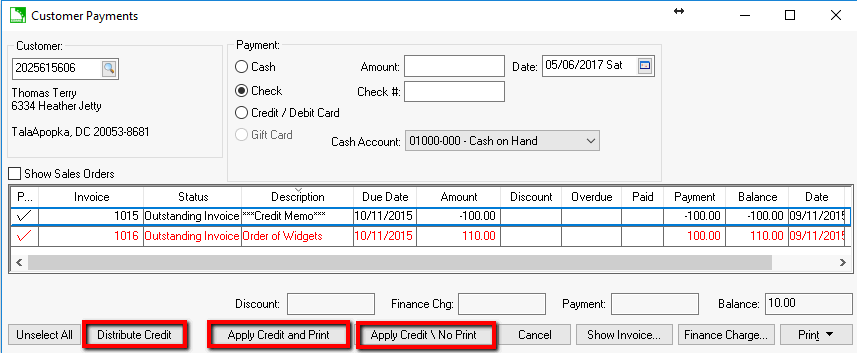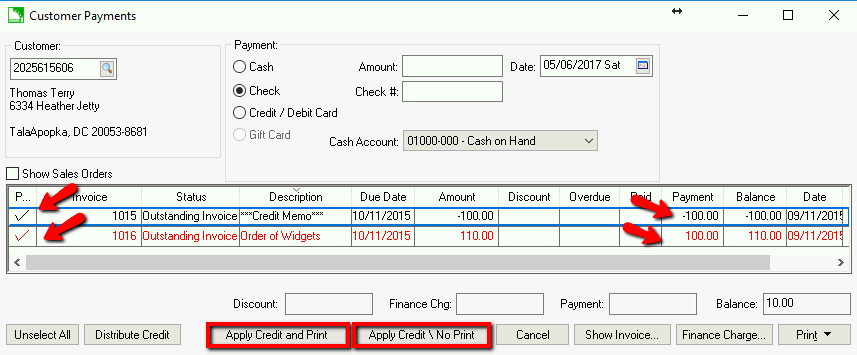Processing Customer Credits
Generating a customer credit may be required for a number of reasons:
-
Overpayment: A credit may result from an overpayment on a sales invoice.
-
Product return: A credit may need to be generated to process returned merchandise.
-
Credit invoice: A credit menu may be required to credit a customer for any other reason.
Complete the following steps to generate a customer credit:
-
Go to Sales > Invoices and S.O.s and click New to open a sales invoice entry window.

-
A customer credit is processed the same as a sales invoice in EBMS, except the total is less than zero (a negative amount), which creates a credit memo. The user may want to prefix the invoice number with the letter C to identify the credit memo. For example, invoice number 10134 becomes C10134. Enter other invoice header data with the same information that would be used in a standard invoice.
-
If inventory items are returned, the Quantity and Shipped columns should be negative. The Customer Returns dialog will appear if the Sales returns item selection setting is properly set within the Advanced tab of the product record. Review the Product Returns and Sales History section within the inventory documentation.
-
Verify the credit Price. This price is copied from the original purchase price if the return is selected from the Customer Returns dialog list.
-
To apply the credit memo toward another invoice, select the Charge payment method. Process the credit and then review the following section for instructions to refund the credit to an outstanding invoice.
-
Process the credit invoice by selecting Process > Process from the invoice menu if you wish to print a credit memo or select Process > Process / No Print to process the credit but not generate a printed document.
-
Review the Refunding Customer Credits for steps to generate a payment to the customer.
Applying a Credit to an Outstanding Invoice
-
Go to the Sales > Customer Payments window to apply the credit to another invoice.

-
Enter the Customer ID.
-
The Cash Account setting can be ignored since the payment amount is zero.
-
The Check # field can be ignored and the Amount left blank or zero.
To Automatically Distribute the Credit from a Credit Memo to the Customer's Invoices:
-
Select the Customer on the Sales > Customer Payments page and click the Distribute Credit button.
-
Click Apply Credit and Print or Apply Credit / No Print.
-
The Credit has been automatically applied.

To Manually Distribute the Credit from a Credit Memo to the Customer's Invoices
-
Select each of the customer's credit memos (invoices with negative balances) from the Sales > Customer Payments page.
-
Select all the invoices you wish to apply the credit to, but make sure that you review and adjust the invoice payment amount column to bring the payment amount at the top to zero. You can edit the amount in the Payment column to distribute the Credit as you wish. The invoice is not required to be paid in full.
-
Click the Apply Credit and Print or Apply Credit / No Print to apply the credits to the invoices.

Review the Refunding Customer Credits for steps to generate a payment to the customer.
Apply a Credit using Recurring Billing
Review Recurring Billing > Applying Customer Credits to use the recurring billing process to apply credits.